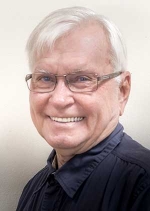 Pictured above is Senior Tech & Owner of HANDS-ON Consultations (HOC) Harv Oliver at his office in Fillmore. HOC was pleased to announce its 20 year Anniversary this past Saturday, July 14th, serving the community fulltime with computer support. HOC has serviced businesses in the communities of Ventura and Los Angeles Counties and beyond. Enlarge Photo By Anonymous — Wednesday, July 18th, 2018
HANDS-ON Consultations (HOC), Computer Support Services, a Fillmore, Ventura County based company, is pleased to announce our twenty (20) year anniversary in business as a full-time computer support company serving business and home users in the communities of Ventura and Los Angeles Counties and beyond. In July of 1998, Harv & Patti Oliver established their computer support services company out of their home in Fillmore, CA. The startup business began after owner and Senior Tech Harv Oliver decided to put his services and skills to work with his own business plan. The skillset at that time was developed working for the Department of Defense in the “mainframe” world and then evolved to include Personal Computers (PC’s) as they were incorporated to the mainframe operations/networks, and eventually, as they are today in nearly every business and home. Twenty years ago, July 14th, HOC assisted their first client. For those of you who recall, this was Archer Chiropractic with offices on Central in Fillmore. At the same time, we assisted Shuel Chiropractic with offices on Main in Santa Paula, as the two doctors worked on a developing effort together. In the twenty years since, HOC has assisted with thousands of service calls and clients to keep their computer operations working. In their original business plan, there was never an intent for a storefront, but to provide “HANDS ON” services onsite for businesses and home users or in the HOC offices as required. Trying to maintain an inventory in such a fast moving and ever-changing field, based on location, population, etc. was evaluated as impractical and this business model has worked well. In July 2001, due to business expansion and requirements, the business transitioned leasing offices from Aguirre Financial & Insurance Services in their current location in the Gurrola Building at 606 Sespe in Fillmore. “We primarily provide ‘field services'”, Harv stated. “We do schedule appointments and system drop-offs at the office however the bulk of our work is ‘onsite’ at client facilities or homes.”. Clients have expanded to hundreds of home users, business medical & dental practices, engineering, manufacturing, travel agencies, insurance providers, and many more. Harv provides technical support services and manages the day-to-day operations with Patti providing support in operations and continuing business development. Through the years, experienced and qualified technicians have provided additional support activities and in 2012, after six months in a supporting role, Tobias Knowles was a hired as a second full-time technician to assist the growing client base. Toby’s skillset in programming, networking, systems repair, and Server Administration have been a huge and valued addition to the HOC team. Cynthia Chessani has provided the bulk of accounting/bookkeeping & administrative services for over ten years – a true asset and part of the HOC family. And while she recently moved on to her new full-time position providing the skills developed in her six years assisting HOC, a shout out to Daisy Palma, who starting from the Fillmore High School ROP student program, assisted with miscellaneous administrative support activities. Additional technicians, administrative personnel, and program developers provide miscellaneous support services as needed to enhance the primary support staff. “Providing professional, friendly services, while building mutually beneficial relationships has always been our goal”, stated Harv in noting the anniversary. “When we started, I asked myself, ‘How can we separate our services and rise above the multitude of other support services out there?’ In any service industry, providing outstanding customer service and dealing honorably with our clients are the most important factors, in my opinion, and that’s what we’ve always tried to do. We all know you can’t please everyone, but at HANDS-ON Consultations we do our very best and our continuing success in the local communities reflects that. Word of mouth and referrals are the keys to success for any business. I believe sustaining a healthy business for 20 years is a strong statement for our approach and services.”. HOC services are provided for business and home users alike. Ranging from hardware/software troubleshooting, repairs and upgrades, computer components, new computer systems to network design, development, & support to web design, development, and hosting to training for Windows and associated applications. Services also include security solutions, malware data protection/restoration, and program and database software development. HOC provides incidents support services, along with scheduled maintenance plans and are aligned with other vendors in various support contracts. Server Administration/Management is another key area of services provided. Of course with todays ‘online’ advancements, services are also often provided ‘remotely’ which is a win-win as client’s issues can often be addressed in a timelier fashion, which is the real goal – to get things working properly as soon as possible. “I’d like to thank all the members of the private and business communities we serve for assisting us in reaching this milestone. Success is many things and we are meeting and achieving the goals we set for ourselves 20 years ago. We’ve seen a number of businesses come and go and surviving each and every year, particularly with an ever-changing and challenging economy, in any kind of business, is tough and this is something we’re very proud of. We look forward to continuing to assist our friends and associates in this ever-developing and exciting field now, and into the future. We’re not done yet!” Harv Oliver, Senior Tech/Owner More information is shared at the HOC web site: www.hocsupport.com |
|
By Anonymous — Wednesday, July 18th, 2018
 The old Piru Post Office, located adjacent to 600 block of Piru Square, is scheduled to be demolished soon. It was originally a house built around 1900. Enlarge Photo |
|
By Anonymous — Wednesday, July 18th, 2018
 On Monday, July 16th at 9am the Fillmore Piru Basin Groundwater Sustainability Agency held a Public Outreach meeting to discuss the GSA’s FY 2018-19 Budget, Basin Prioritization ranking, basin boundary Modification, the development of Groundwater Sustainability plans and more. Members of the community were encouraged to attend and voice their opinions and/or concerns. Enlarge Photo |
Now Hiring: Deputy City Clerk
The City of Fillmore is seeking a detail-oriented and highly organized professional to join our City Clerk’s Office as Deputy City Clerk. This key role supports City Council operations, maintains official records, ensures legal compliance, and helps uphold transparency in local government. If you’re passionate about public service, governance, and supporting elected officials, we encourage you to apply. Learn more and apply at www.fillmoreca.gov.
|
By Anonymous — Wednesday, July 18th, 2018
 On Friday, July 13th at 9:20pm on First and Fillmore Street where a brown pick up truck rear ended a white pick up truck. Cause of the accident is still under investigation. Enlarge Photo |
|
By David W. Rowlands — Wednesday, July 18th, 2018
Porch Fest – 2018 The Bridges subdivision, located east of Rio Vista Elementary School, has been selected as the host location for the first ever Porch Fest. This is a community event that celebrates music and community. The event is an open invitation to whomever wants to drop by and enjoy the live music which will be performed on front porches, yards or driveways within The Bridges subdivision. Porch Fest will be held Saturday, August 4th from 5:00 pm to 7:00 p.m. Information on band locations and bands will be on the city web site www.fillmoreca.com and Twitter page. Parking is available on the street. The “All Digital String Band” will be performing traditional Bluegrass with highlight performances from local Fillmore musicians. Notable local blues festival favorite “The Kingfish” will stop by for a short cameo acoustic performance. Kingfish is a favorite at the Long Beach Blues Extravaganza where he performs with his band The Other Mules. Fillmore Association of Businesses – FAB Up and Running FAB is an association of downtown business owners, managers and property owners working together to bring innovative ideas and events to promote a sustainable, energized, and creative environment within Fillmore’s downtown business perimeter. FAB will work in sync with the City’s Downtown Strategic Plan focusing on business retention, expansion, and attraction. If you are interested in joining or have ideas to share please contact Ernie Villegas, Special Projects Manager at (805) 524-1500. Entrepreneurs – Fillmore Now Allows Pop-Up Businesses The City Council recently changed its laws to allow “pop-up” businesses to locate within the Commercial Highway, Central Business District, Commercial Neighborhood, Manufacturing/ Industrial and Business Park zones in the City if the business is a permitted use or allowed with a Development Permit in that zone. Businesses will be allowed for an initial time of 45 days and up to a maximum of 90 days without needing to seek entitlement permits. Allowing additional temporary uses in the zones will promote economic vitality by temporarily locating business and uses in buildings and structures which might otherwise remain vacant. Fillmore Pavement Resurfacing Completed Paving was recently completed on portions of B Street, C Street, D Street and Mountain View Street. Let’s work together to keep Fillmore the “Best Last Small Town.” David W. Rowlands, Fillmore City Manager |
 Photo of the Week "Fireworks!" By Bob Crum. Photo data: Canon 7DMKII camera, bulb mode, ISO 400, Tamron 16-300mm lens with 0.6 ND filter, aperture f/11, exposure 14 seconds. Enlarge Photo By Bob Crum — Wednesday, July 18th, 2018
Exposures exposed
I've been shooting the Fillmore fireworks show for about 87 years, so it seems. In years past, I noticed that bright bursts are, you know, too bright resulting in blown out highlights. No big deal considering there isn't any detail in bright light blobs. But super bright lights tend to overpower the image. Attempts to cool down the highlights in post processing just make the highlights an ugly shade of gray. I'd like a better balance of the bright light and colors while executing longer exposures. So what to do? A Ventura friend photographer suggested installing an ND filter on the lens. Hmm. An ND filter reduces light coming into the lens like sunglasses for your eyes. Why do that? Because theoretically reducing light entering the lens allows for longer exposures without overexposure. BTW, works wonderfully for photoing mermaids frolicking in squally seas. I decided to use a 0.6ND on my Tamron 16-300mm lens which will reduce the exposure equivalent to 2 f/stops. One disadvantage of using an ND filter is that it darkens what you see through the viewfinder rather dramatically. Worse, depending on the filter used auto-focus may not work. However, neither issue was a problem regarding fireworks photography. I simply used the camera's live view (LCD screen) to initially compose the images and used manual focus with the lens set at infinity. The only problem is that live view goes dark the instant the shutter is actuated so can't tell what is being recorded. Hello guesswork! The overall range of my firework exposures is from 3 to 14 seconds for a reason described below. Did the 0.6 ND filter accomplish the anticipated results? Yes with an unexpected benefit. The foreground is better exposed from the ambient light the result of longer exposures. A delightful bonus. Love surprises! It's important because what are fireworks for if not to be observed? So, from my perspective, adding people in the foreground provides some 'show' context. Knowing that a train with people on open-air flat cars will be parked near the firing stage, I took a position between the train and Old Telegraph Rd. Viola... people and fireworks thanks to the ND filter. Now, about the long 3 to 14 second exposures. A single firework burst is not by itself necessarily impressive. On the other hand, two or three bursts in a single frame... now that's exciting! I could shoot single bursts and create composites afterward. Composites are simply the blending of two or more images to create one final image. While this definition makes compositing sound quick and easy, it’s anything but, often times requiring several hours of editing work to complete. I don't have the luxury of time to create composites. So I go rogue and improvise. When the first firework is fired into the air, I open the shutter... and hold it open (in bulb mode) for the duration of two or three firework bursts. This is like creating a composite in the camera. Much quicker to do it in camera... another reason for the ND filter. Now you know a craft secret. Shhh. See the fireworks slide show video featuring John Wayne and Kate Smith: https://youtu.be/aggnhfHH5Gk Happy photoing. Send comments, questions or suggestions to: photography@earthlink.net |
|
By Bob Crum — Wednesday, July 11th, 2018
Part 1 of 4
 On Wednesday, July 4th Fillmore celebrated Independence Day with the 32nd Annual Sespe Creek Car & Cycle Show. The day’s festivities included the 4th of July Chili Cook-Off & Beer Fest where families were able to enjoy the cars, food, music and more. In the evening locals and visitors also enjoyed the fireworks show at 9pm. Photos courtesy Bob Crum. Enlarge Photo |
|
By Bob Crum — Wednesday, July 11th, 2018
Part 2 of 4
|
|
By Bob Crum — Wednesday, July 11th, 2018
Part 3 of 4
|

























































